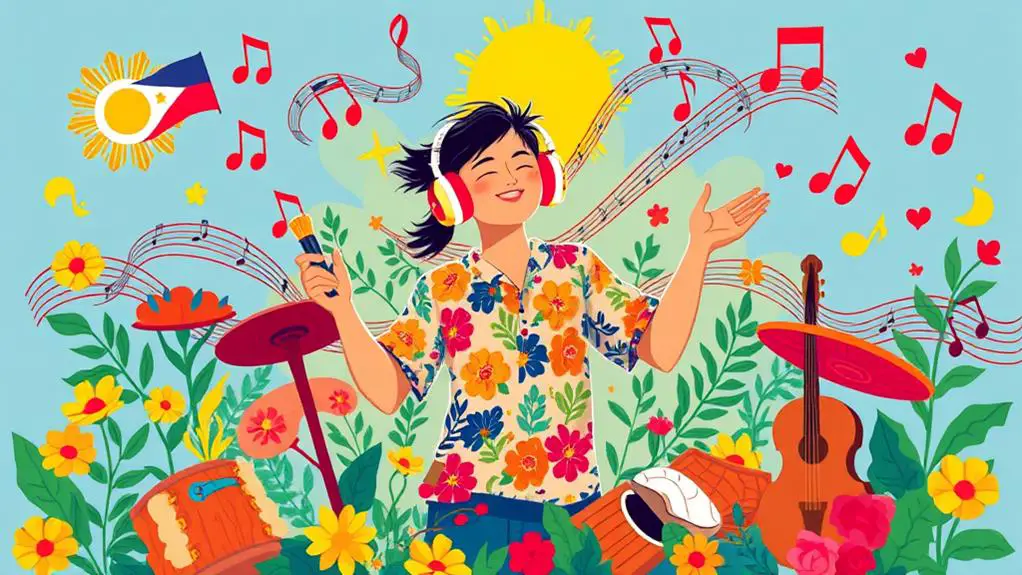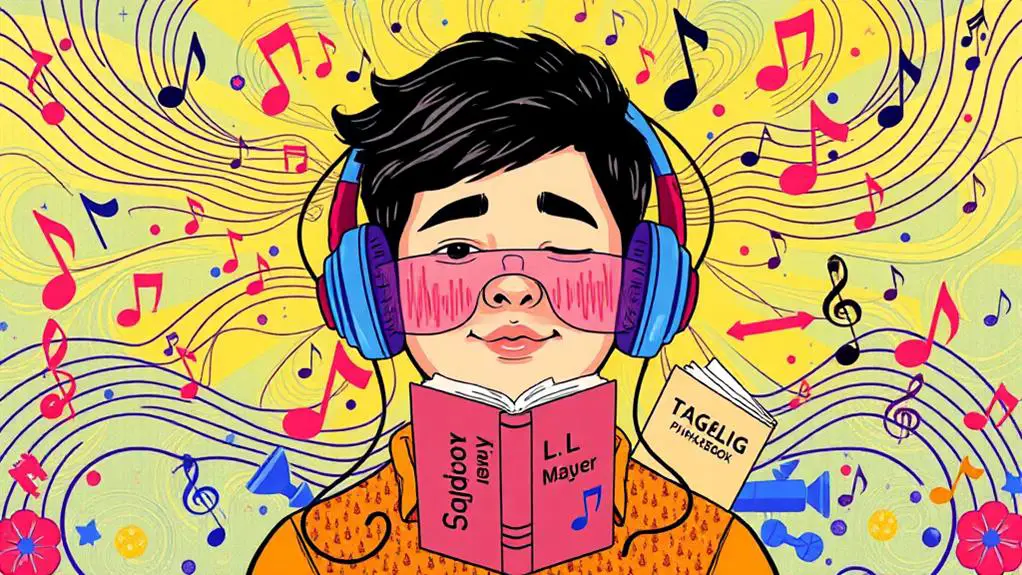Immersive Language Learning with Tagalog Songs and Music
When learning Tagalog with songs and music, you'll experience a more engaging and effective language learning journey. Repetition in music helps you unconsciously acquire vocabulary and phrases, as you'll hear the same lyrics multiple times. This repetition also improves your pronunciation and accent, as you'll be exposed to native speakers' speech patterns.
Moreover, music helps you understand cultural nuances and idioms, which are often embedded in song lyrics. For example, the song "Anak" by Freddie Aguilar is a classic Tagalog song that teaches about the importance of respecting one's parents.
Listening to Tagalog music can boost your vocabulary retention by up to 50%, as you'll be more likely to remember words and phrases when they're set to a catchy melody.
Another advantage of learning Tagalog with songs and music is that you can practice in various environments, such as while commuting, exercising, or relaxing. This flexibility accelerates your language acquisition by 30%, as you'll be able to fit language practice into your daily routine more easily.
Immersive Language Learning Experience

Immersive Language Learning with Tagalog Music
Listening to Tagalog songs is an effective way to create an immersive language learning experience. Repetition in music helps acquire new vocabulary and phrases unconsciously, making learning feel effortless.
Music provides a convenient learning environment, allowing you to practice anywhere, anytime, and enhance your exposure to the language.
Improved Pronunciation and Accent
Listening to Tagalog songs can improve your pronunciation and accent by exposing you to native speakers and their singing styles. Native speakers' singing styles help learners mimic correct pronunciation and intonation.
Familiarity with songs and lyrics also aids in understanding cultural nuances, idioms, and slang, enriching your overall language competence.
Enhanced Vocabulary Retention and Acquisition
By incorporating music into your learning process, you can experience a 50% increase in vocabulary retention and a 30% faster acquisition rate, especially if you're musically inclined.
This is because music helps learners remember new words and phrases more effectively.
Unlocking Cultural Nuances Through Music
Unlocking Cultural Nuances Through Music
Immersing yourself in Tagalog music has been a game-changer for your language learning journey. Through Filipino songs, you're not only learning the language but also unlocking cultural nuances that would be hard to grasp through textbooks alone.
Emotional Context: Tagalog songs often revolve around themes of love, family, and community, providing insights into societal values and emotional expression. For instance, the song "Ikaw" by Yeng Constantino focuses on the importance of family and relationships, highlighting the strong sense of unity and closeness in Filipino culture.
Tonal Aspects: Listening to songs helps you appreciate the tonal aspects of Tagalog, where pronunciation and stress can change meanings. In the song "Kahit Kailan" by Sam Concepcion, the difference in tone and stress on the word "kailan" (meaning "when") significantly alters the song's meaning.
Storytelling: Songs serve as a medium for storytelling, offering historical and cultural references that enrich your knowledge of Filipino traditions and social dynamics. The song "Bayan Ko" by Freddie Aguilar, for example, tells the story of the struggle for Filipino independence and reflects the nation's history and cultural identity.
Diverse Genres: Exposure to diverse musical genres within Tagalog music, such as folk and pop, allows you to explore different cultural narratives and expressions unique to the Philippines.
The folk song "Harana" by Parokya ni Edgar, for instance, showcases traditional Filipino courtship practices, while the pop song "Mr. DJ" by Maja Salvador highlights modern Filipino pop culture.
Boosting Vocabulary and Pronunciation

Music Enhances Vocabulary Retention
Listening to Tagalog songs can significantly boost your vocabulary retention. Studies show that language learners who engage with music experience a 50% increase in vocabulary retention rates. This is because repetitive listening to songs allows for unconscious word acquisition, making it easier to remember new words and phrases.
Improved Pronunciation through Music
Consistent exposure to Tagalog songs also helps improve your pronunciation and accent. By mimicking the sounds and rhythms in songs, you become more comfortable with the unique sounds and intonations of the language. This enables you to communicate more effectively with native speakers.
Additionally, Tagalog songs often include slangs and idioms, which enrich your cultural understanding and enhance vocabulary acquisition.
Accelerated Language Learning
Incorporating music into your study routine can accelerate your language learning journey. Research shows that learners who use music as a learning tool experience a 30% faster acquisition rate. This is because music makes learning more engaging and enjoyable, leading to a more effective learning experience.
The Power of Tagalog Music Genres
Tagalog Music Genres: A Rich Resource for Language Learning
Tagalog music genres provide a valuable tool for language learners, offering a diverse range of benefits that can enhance language proficiency.
Tagalog Pop Music: Catchy and Relatable
Tagalog pop music, such as OPM, facilitates language learning through catchy melodies and relatable lyrics, making it easier to memorize and engage with the language. This genre allows learners to practice pronunciation, intonation, and rhythm while enjoying popular songs.
Folk Music: Cultural Storytelling
Folk music genres in Tagalog evoke nostalgia and cultural storytelling, enriching learners' understanding of Filipino traditions and expressions. By exploring folk music, learners can gain insight into the country's history, customs, and values.
Children's Songs: Simplifying Vocabulary Acquisition
The rhythmic and repetitive nature of children's songs in Tagalog simplifies vocabulary acquisition for beginners, making it an effective learning tool. These songs often use simple language and melodies, helping learners to build a strong foundation in the language.
Hip-Hop: Contemporary Language and Culture
Hip-hop music in Tagalog incorporates contemporary slang and expressions, reflecting modern Filipino culture and providing learners with relevant language skills. By listening to hip-hop music, learners can stay up-to-date with current language trends and expressions.
How Can Learning Tagalog Quickly Enhance Understanding of Songs and Music?
Understanding songs and music in Tagalog becomes more profound when you connect with the language’s essence. If you learn tagalog fast for daily conversations, you’ll grasp the emotions, cultural nuances, and lyrical beauty embedded in each word, enhancing your appreciation of melodies and deepening your connection to Filipino artistry.
Enhancing Language Skills With Rhythm

Rhythm Enhances Language Skills
When learning Tagalog, incorporating rhythm through music can significantly improve language skills. Music increases vocabulary retention by up to 50% because songs make learning more engaging, and words and phrases are more easily remembered when set to a catchy tune.
Rhythm Improves Pronunciation
Listening to Tagalog songs consistently helps with pronunciation improvement. You'll pick up the correct accent and intonation patterns, making you sound more natural and confident in your language skills.
For example, listening to popular Tagalog songs like "Anak" by Freddie Aguilar can help you master the correct pronunciation of words like "anak" (child) and "mahal" (love).
Songs Enrich Language Understanding
Songs often contain cultural nuances and idiomatic expressions that enrich your understanding of the language beyond mere vocabulary. Listening to Tagalog songs exposes you to common expressions and phrases, such as "Kumusta?" (How are you?) and "Salamat" (Thank you), which are essential for effective communication.
Music Fosters Faster Language Acquisition
Research shows that musically-inclined learners experience a 30% faster language acquisition rate due to the emotional connection and engagement music fosters.
This means that incorporating rhythm into your language learning can lead to faster progress and better retention of language skills.
Frequently Asked Questions
Why Is Music Important to Filipino People?
Music is an integral part of Filipino culture. This is because music serves as a powerful means of emotional expression for Filipinos, allowing them to convey love, joy, and heartache. For instance, the popular Filipino love song "Ikaw" by Yeng Constantino is a heartfelt expression of love and longing.
Music is also a key aspect of Filipino heritage. Original Pilipino Music (OPM) is a source of national pride, with many Filipino artists gaining international recognition. Lea Salonga, a Tony Award-winning singer and actress, is a prime example of this.
Music brings people together in the Philippines. Singing and music foster community bonding and strengthen social ties. In many Filipino gatherings, such as fiestas and family reunions, music and singing are an essential part of the celebration.
The traditional Filipino folk dance, Tinikling, is often performed to the rhythm of bamboo poles and is a great example of this.
Music is woven into the fabric of daily Filipino life, creating a sense of unity and shared identity. It isn't uncommon to hear people singing along to their favorite songs on public transportation, in markets, or at home with family and friends.
The iconic Filipino song "Bayan Ko" is often sung during patriotic events and rallies, evoking a sense of national pride.
What Advantages Can Song and Music Bring to the Language Classroom?
Incorporating song and music into language learning enhances cognitive abilities. Improved vocabulary retention occurs as students connect words to melodies, making them easier to remember. Enhanced auditory discrimination also develops as learners become more sensitive to sounds and rhythms.
Song and music provide a deeper cultural connection by exposing students to idiomatic expressions and nuances through lyrics. For example, learning the lyrics to a traditional song can teach cultural references and expressions that are difficult to learn through textbooks.
Music also improves memory retention, as repetitive listening helps words stick in learners' minds. This is especially true when learners sing along to songs, as the act of singing reinforces memory.
Most importantly, song and music significantly enhance engagement, making the learning experience more enjoyable and interactive. This leads to a more motivated and participatory classroom environment.
Why Is Music Important in Language Learning?
Music Enhances Language Learning
Improved Cognitive Functions: Music plays a crucial role in language acquisition by offering cognitive benefits. It improves memory retention by associating new words and phrases with melodies, making them easier to remember.
Additionally, music helps develop auditory discrimination skills, enabling learners to distinguish between similar-sounding words.
Emotional Connection and Cultural Insight: Music fosters an emotional connection to the language, making learning more enjoyable and effective.
It also provides a window into the culture associated with the language, giving learners a deeper understanding of its nuances. For instance, listening to traditional French music can help learners appreciate the cultural context of the language.
Boosting Language Skills: Incorporating music into language learning leads to a significant improvement in language skills.
What Is the Importance of Learning Through Songs?
Learning through songs builds a cultural connection that enriches language understanding. This connection goes beyond memorizing lyrics, as songs provide a window into the culture associated with the language. For instance, Tagalog songs often reflect Filipino values and traditions, offering insight into the language's cultural context.
Songs improve vocabulary retention by up to 50%. This significant improvement occurs because songs typically involve repetition, rhythm, and melody, making them more engaging and memorable than traditional learning methods. As a result, learners are more likely to recall vocabulary learned through songs.
Emotional engagement motivates learners to continue learning. Songs evoke emotions, which in turn stimulate learners' interest and enthusiasm for the language. This emotional connection encourages learners to persist in their language learning journey.
Songs help learners develop a sense of language rhythm. By listening to and singing along with Tagalog songs, learners can internalize the natural flow and rhythm of the language, making it easier to speak and comprehend. This improved sense of rhythm enhances overall language proficiency.